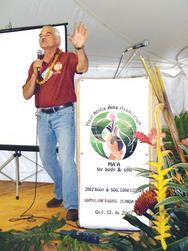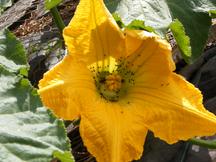Revelations from MAA's Body & Soil Conference
by Rob ParsonsOctober 18, 2007
 |
 |
 |
Organic farming is rooted in ancient knowledge passed down through generations. Long before science could tell us why certain farming methods would produce greater crop yields, organic farmers were learning the hard way what worked and what didn't-sharing their knowledge with others.
-David Suzuki
Think "organic gardening" and you're likely to think of "quaint," "old-fashioned" or something practiced by hippies on communes, but unrealistic for most farmers. To 100 participants gathered for two days high atop Olinda Road at Kumulani Farms for Maui Aloha "~Aina's sixth annual Body & Soil Conference, nothing could have been further from the truth.
Indeed, a number of scholarly presenters, world-renowned as experts in their fields, tantalized the diverse audience with insightful revelations of the connections between all forms of life. The short version was this: soil health, plant health, human health and ecosystem health are all inextricably, unquestionably interconnected. On an island where heavily chemicalized monoculture crops have ruled over the past century, the conference provided a workable blueprint for the future.
Gary Zimmer, a Madison, Wisconsin dairy and diversified farmer, author and educator, offered his vision of a "local choice farmer's market on the corner by every McDonald's," where people can choose between "fast food" and real, healthy, locally grown food. Zimmer is the author of the book, The Biological Farmer, A Complete Guide to the Sustainable & Profitable Biological System of Farming, published in 2000. His focus remains on the soil as the source of nutrients: how healthy soils produce healthy plants for healthy livestock and healthy humans.
Zimmer is so brimming with knowledge that his rapid-fire delivery invigorated the audience. Among his recommendations were: get a soil test; use fertilizers that do the least amount of damage (including naturally mined minerals); maximize plant diversity; use a minimum amount of tillage; feed the crops with mulch; rest the soil when needed; and feed the soil life-the microbial organisms that work symbiotically to convey nutrients to the growing plants.
Bob Shaffer, a 30-year organic farmer and soil consultant, owns and operates a coffee and macadamia nut farm on the Big Island, and also works through Napa Valley College as an instructor for cover crops for vineyards. Shaffer said many Hawai"~i soils have extreme deficiencies and imbalances, having lost their original soil health. Bare soil is the enemy, he said, because plants and cover crops carry energy (carbon) into the soil, feeding the living microbial biomass.
 |
 |
 |
Shaffer listed "Seven critical, irreplaceable functions" performed by these soil microbes: decomposition of organic matter; retaining minerals from decomposition; recycling of immobilized minerals; plant growth promotion; plant disease prevention; aggregation of soils; and decomposition of toxins. He added that the year-round availability of organic matter for the soils is a big advantage for gardening and farming in the tropics.
Dr. Sherrill Sellman, a naturopath, lecturer and best selling author, offered a sobering presentation titled, "Hormones, breast cancer, cell phones, and EMFs" (Electro Magnetic Fields). On her way to a three-week lecture tour in Australia, Sellman focused on how prevalent man-made electro-magnetic fields have become in the past 20 years.
With virtually no pre-market testing done on this technology before cell phones were introduced, there were no studies on the effects of electro-pollution. "We are the guinea pigs for this new phenomenon," she said. Now with more than 300 studies conducted worldwide, the conclusions are grim. Even if we're not cell phone users, we are at risk to a variety of ailments, including brain cancer, because of the proliferation of cell phones around us.
There are three billion cell phones in use worldwide, representing about half the population of planet Earth. There are more than 240 million cell phone users in the United States, and there are close to two million cell phone towers and antenna sites. (check www.antennasearch.com to find those in an eight-mile radius from where you live). Artificial electromagnetic fields cover virtually all the habitable parts of the planet.
The "dark side of the technology," is that these man-made frequencies disturb receptor sites in our cells. They harden cellular membranes, making it difficult for cells to absorb nutrition or to expel waste. They alter our endocrine systems, changing the way we produce essential hormones like melatonin, serotonin and dopamine.
Fortunately, Dr. Sellman also offered some solutions, including chips on cell phones, wearing universal chips to strengthen resilience against the stress of EMFs from many sources and good nutrition to bolster the body's ability to cope with the invisible electro pollution which surrounds us (www.mybiopro.com/yes).
Nutritionist Jerry Brunetti seemed equally comfortable discussing the dynamics of human health as with touting soil and plants as holistic systems. Having cured himself of non-Hodgins lymphoma after being given six months to live, he has released a DVD titled Food As Medicine, or, as he put it, "Farm as farmacy."
Brunetti expounded at length about the benefits of earthworms as primary digesters of organic wastes. He said 2,000 worms create 125 pounds of worm castings per year-a dynamic, complex soil amendment.
He described that the nectar produced by flowers may contain as many as 40 compounds, besides the 30 percent sugar that attracts pollinators. For this reason, he believes that hive collapse disorder is likely caused in part by beekeepers feeding corn syrup solution to their honeybees, which then miss dozens of other essential nutrients. He also described the nectars produced by the root tips of healthy plants, and their symbiotic relationship with the microbial biomass in the soil, which he said makes up half of all the earth's organisms.
Maui Aloha "~Aina has sponsored the Body & Soil Conference since 2001, assisted in part by a County of Maui grant from the Office of Economic Development. Maui County Farm Bureau member Vince Mina of Kahanu Aina Sprouts founded MAA and began the conference. He said he started looking at how to sustain vitality after observing fluctuations in his own health, as well as ways to bring outreach and education to the community.
The participants were diverse: a Keanae taro grower with 69 different varieties; a grower of ayurvedic herbs; an Olinda fruit orchard farmer; Hana organic farmers; the founder of GMO Free Maui; a director from Monsanto; an environmental researcher; and a hula halau participant looking to restore a Waiehu mac nut field using appropriate cultural and holistic methodologies.
Also present was a contingent of interns working with Maui Land & Pineapple Co.'s new Kapalua Farms branch. Among those were several students and graduates from Earth University in Costa Rica, an alliance originally forged as part of the Sustainable Living Institute of Maui (SLIM) initiative with ML&P and Maui Community College.
Under the guidance of Tova Callendar of ML&P, the Kapalua Farms program emerged from the Maui Ag Partners of a couple years ago, which looked to make compost and pursue organic gardening of diversified crops.
Three third year Earth University students, Christian Golcher, Maria Andrea Barquine and Rebeca Salazar are doing hands-on farming of vegetables and herbs on a small-but-growing plot of land. They practice composting, vermiculture, cover cropping, work with value-added farm products and have expanded into a free-range poultry venture. Organic practices are undertaken while certification is pending, though ML&P has already certified its Kapalua Gold pineapples. Kapalua Farms produce may be found at a Thursday Farmer's Market at the Honolua Store.
On the same parcel of land between Napili and Pineapple Hill, ML&P employees may grow their own. According to Callendar, 41 families are gardening on the ML&P patch.
Victor Perez is participating in the Scholar Program, doing a post-graduate internship after working for three years at a Costa Rican resort, doing landscaping, golf-course management and construction. He's done research on the Kapalua golf course, seeking to find a remedy for the "fairy ring" fungus. His one-year internship has been extended, and he's managing field operations of organic pineapples.
In our era of fast foods, supermarkets, and cheaply transported foods from factory farms and huge agribusiness ventures, we may overlook the importance of supporting local farmers. Likewise, with only a cursory introduction to nutrition and health taught in most schools, we may not understand the dynamics of what we consume, and how it may enhance or detract from our overall health.
The Body & Soil Conference provided a momentary glimpse of the health and harmony inherent in all living things, and the degree to which the fragile balance of things has tipped perilously towards disease. Understanding the extraordinary intricacies and interplay of living systems is a giant step towards healing oneself, and the planet as a whole.
For more information, visit www.mauialohaaina.org.